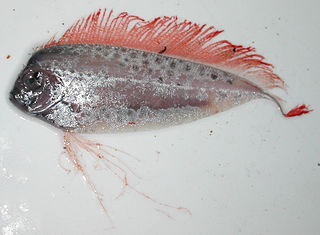
The ribbonfish are any lampriform fishes in the family Trachipteridae. These pelagic fish are named for their slim, ribbon-like appearance. They are rarely seen alive, as they typically live in deep waters, though are not bottom feeders. The perciform fish known as the red bandfish is sometimes referred to as ribbonfish, but it is unrelated to any ribbonfish in the Trachipteridae.
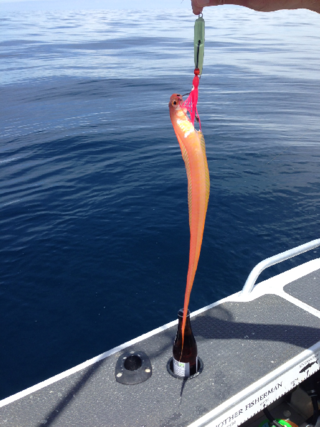
Cepola haastii is a species of marine ray-finned fish belonging to the family Cepolidae, the bandfishes. It is found on the inner continental shelf around New Zealand. Its length is between 15 and 25 cm. This species is known as the red bandfish, a name given to most of the other members of the genus Cepola, especially the European species, Cepola macrophthalma.
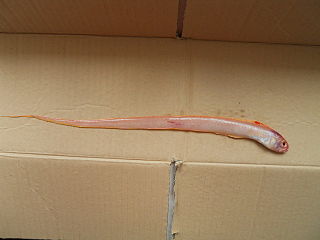
The bandfishes, family Cepolidae, are 23 species of marine ray-finned fishes, They are native to the East Atlantic and Indo-Pacific wherethey dig burrows in sandy or muddy seabeds and eat zooplankton.

Nemipteridae, the threadfin breams or whiptail breams, is a family of marine ray-finned fishes belonging to the order Spariformes. These fishes are found in the Indo-West Pacific region.
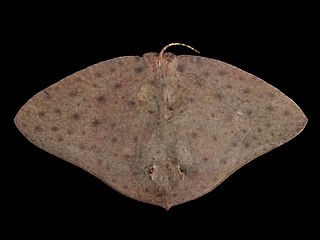
The smooth butterfly ray is a species of cartilaginous fish in the family Gymnuridae. It is a member of the order Myliobatiformes, which contains 10 total families. Its natural habitats are shallow seas, subtidal aquatic beds, estuarine waters, and coastal saline lagoons. Its common name is derived from its compressed body, pectoral fins that are wider than their length, and overall diamond shape.

The thornback ray, or thornback skate, is a species of ray fish in the family Rajidae.

Cepola is a genus of marine ray-finned fishes belonging to the bandfish family, Cepolidae. The name red bandfish is applied to all members of this genus, but particularly C. macrophthalma, and generally not C. australis, which is also known as the Australian bandfish.
Cepola pauciradiata, the Guinean bandfish, is a species of marine ray-finned fish belonging to the family Cepolidae, the bandfishes.. It is found on the Atlantic coast of Africa.

Eledone moschata, the musky octopus, is a species of octopus belonging to the family Octopodidae.

Acanthocepola is a genus of marine ray-finned fishes belonging to the family Cepolidae, the bandfishes. They are native to the Indian Ocean and the western Pacific Ocean.
Owstonia is a genus of marine ray-finned fish belonging to the family Cepolidae, the bandfishes. It is the only genus in the monotypic subfamily Owstoninae. They are found in deep waters of the Indian and Pacific Ocean.

The blue blanquillo, Malacanthus latovittatus, also known as the banded blanquillo, striped blanquillo, false whiting, sand tilefish or eye of the sea, is a species of marine ray-finned fish, a tilefish belonging to the family Malacanthidae. It is found in the Indo-Pacific.

Caesio teres, the yellow and blueback fusilier, beautiful fusilier, blue and gold fusilier or yellow-tail fusilier, is a species of marine, pelagic ray-finned fish belonging to the family Caesionidae. It occurs in the Indian and Western Pacific Oceans.
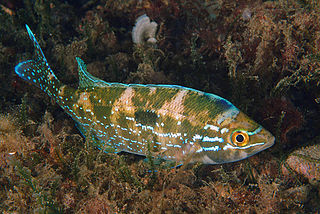
Spicara maena, the blotched picarel, is a species of ray-finned fish native to the eastern Atlantic Ocean, the Mediterranean Sea and the Black Sea. The male grows to a maximum length of about 25 cm (10 in), and the female reaches 21 cm (8 in). This fish is fished commercially in some areas.

The Australian bandfish is a species of bandfish in the family Cepolidae. It has been reported from the Indo-Pacific coastal regions of Australia, New Zealand, and New Caledonia, although some of these records may represent confusion with other species.
Cepola schlegelii i is a species of marine ray-finned fish belonging to the family Cepolidae, the bandfishes. It is found in the Indo-West Pacific region.
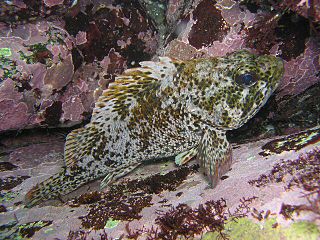
Sebastes pachycephalus is a species of marine ray-finned fish belonging to the subfamily Sebastinae, the rockfishes, part of the family Scorpaenidae. It is found in shallow rocky reefs of Northwest Pacific.

Jaydia queketti, the spotfin cardinal or signal cardinalfish, is a species of ray-finned fish from the Indian Ocean, it is a member of the family Apogonidae. It has colonised the eastern Mediterranean Sea by way of the Suez Canal since 2004.

Cepolinae is one of two subfamilies of marine ray-finned fish belonging to family Cepolidae, the bandfishes.

Siganus spinus, the little spinefoot, scribbled rabbitfish, blunt-nosed spinefoot, spiny rabbitfish, or spiny spinefoot, is a species of marine ray-finned fish, a rabbitfish belonging to the family Siganidae. It is found in the Indo-Pacific region.


















